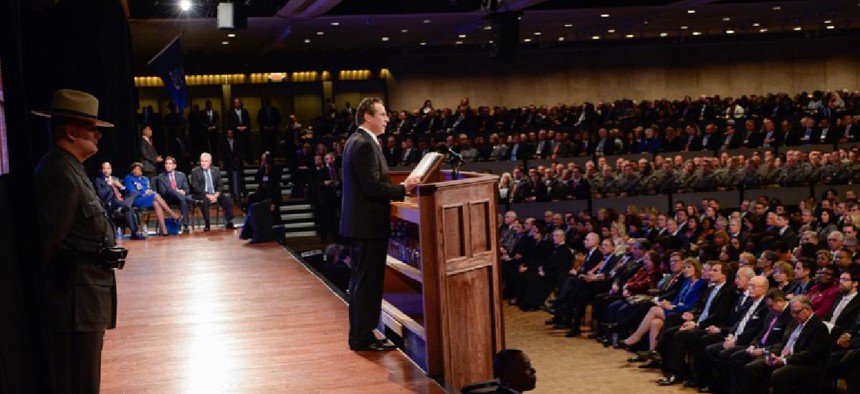Politics
Community schools work, experts say – but how will New York afford them?

Educators and elected officials in New York have long tried to improve struggling schools. Most recently, Gov. Andrew Cuomo allocated $100 million in his 2016-17 executive budget proposal to convert them into community schools in a bid to turn around high-needs districts.
Community schools are an attempt to address student performance by providing services for the community, such as health and legal services, afterschool programs and day care. A “struggling school” is one with low student test scores or graduation rates.
While usually at odds with one another, the state teachers union and education advocates have both applauded the governor’s efforts. Nonetheless, some experts worry the state will not allocate enough money to properly implement the community schools model.
“I think the one thing we would say is that community schools can be expensive to implement, and I think that it would probably need more funding than the governor initially proposed, so we’ll have to see how that plays out during the budget negotiations,” said David Albert, communications director for the state School Boards Association. “But, we do see the community school model as one that holds great promise for improving schools. We support it and would like to see more financial support.”
Of the $100 million in Cuomo’s proposal, $75 million would be allocated among 17 school districts which currently house either a school that has been struggling for a relatively short time or a “persistently struggling” school, which means it has been facing challenges since 2006. The schools will be identified by the state Education Department based on test scores and graduation rates over a decade.
Currently there are 178 “priority” – or failing – schools in the state, according to a 2015 report by Cuomo’s office. Of that number, 77 have been failing for a decade, with more than 250,000 students passing through those schools since 2005.
Cuomo last year tried to address the problem by imposing a stricter teacher evaluation system tied to state tests. He also included in last year’s budget a state receivership system that would allow the state to appoint an outside receiver to step in and oversee a school that has been struggling. Facing backlash, he ultimately walked away from the new teacher evaluation system.
“When you look at the schools that are facing receivership, the wealthiest of them have two-thirds of students living in poverty,” said Carl Korn, chief press officer for NYSUT, the state teachers union. “Students living in poverty and their families face issues that many times are overlooked in the debate about school aid and student achievement. The community schools model supports students and their families by providing the necessary services, and that’s the right way to address schools that are struggling because it takes aim at the No. 1 factor – and that’s poverty.”
Experts applauded Cuomo for including the initiative in his executive budget, but several said they prefer the Assembly’s one-house budget, which includes an additional $100 million for community schools, which would bring the total to $200 million. The Senate one-house budget rejects the executive budget’s proposal to provide $100 million for community schools.
Earlier in March, a state Senate spokesman told Chalkbeat that school districts could decide whether to opt to spend their additional foundation aid funding on community schools.
“I certainly want to see every sector of government – the Senate, the Assembly and the executive – support fairness in our struggling schools, which is to give them enough time to be successful, which is not to say they have forever, but a fair enough amount of time and, certainly, the resources they need to have the kind of wraparound services they need to make these schools more successful,” said Assemblywoman Catherine Nolan, chairwoman of the Assembly Education Committee.
Bob Lowry, deputy director for advocacy research and communications for the state Council of School Superintendents, estimated that the $100 million in the governor’s budget would cover basic operating costs but not much more, and he called for more money for community schools and for the public school system as a whole.
“Community schools are a vehicle for addressing those non-academic issues that can get in the way of success in school,” Lowry said. “But if you’re going to provide funding for new initiatives, how does that balance against the ability of the state to provide adequate general funding for schools?”
Experts say community schools are more expensive to operate than regular public schools, given the additional services they provide.
“Community schools are one of the most innovative and promising initiatives we can have in our public school system and especially in poorer communities,” said Billy Easton, executive director of Alliance for Quality Education, an education advocacy group closely allied with the Assembly Democratic conference.
As with many new initiatives, education experts are excited but cautious about how well the state will implement new community schools, provided that the funding is included in the budget. When New York implemented the Common Core standards in 2010, elected officials and the state Education Department eventually faced severe backlash from educators, students and parents who complained that the implementation was “flawed” and “uneven.” The state is currently overhauling its curriculum.
“It is expensive and we do have to look at the cost and what it really takes to do it effectively and really provide the kinds of services (needed),” Albert said. “I think the Legislature and the governor are going to have to really look at what it costs to do the community schools model effectively.”

NEXT STORY: NY education advocates, officials hope this year is a turning point for funding increase